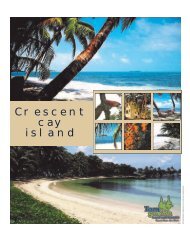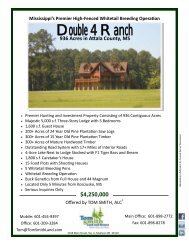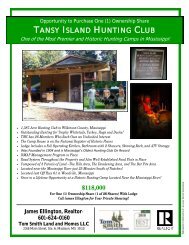brandywine iSland - Megaagent.com
brandywine iSland - Megaagent.com
brandywine iSland - Megaagent.com
Create successful ePaper yourself
Turn your PDF publications into a flip-book with our unique Google optimized e-Paper software.
A PERSPECTIVE ON<br />
<strong>brandywine</strong> ISland<br />
Brandywine Island is an extraordinary property because of the<br />
strength and synergy of three key attributes — location, size<br />
and quality of habitat. The result is enormous potential.<br />
As the old saw in real estate goes—location, location, location!<br />
If ever there is a perfect location, this is it. I am not familiar<br />
with another sporting property of the size and quality of the<br />
habitat and wildlife that is situated as close to a S.M.S.A.<br />
(standard statistical metropolitan area) having a population<br />
in excess of one million. Memphis also happens to have one<br />
of the world’s busiest international airports. Happily, getting<br />
from Memphis to Frenchman’s Bayou is not only a short<br />
drive but a pleasant one as well. Mercifully minimal time is<br />
spent on Arkansas’ truck-choked interstates. Drives to most<br />
of Arkansas’ duck blinds require at least an hour and a half of<br />
high anxiety time on the interstate.<br />
The size of a sporting property is critical to its successful<br />
management. Larger tracts enable optimal management<br />
for a wide variety of fish and wildlife species as well as<br />
permitting simultaneous fishing and hunting for a broad<br />
range of target species. Properties of substantial acreage<br />
also afford protection from any negative influences from<br />
adjoining lands. Brandywine’s size is more than adequate;<br />
indeed its riparian nature provides additional protection<br />
from trespass by virtue of the physical barriers created by<br />
the river, chutes, lakes and sloughs.<br />
The once vast Mississippi alluvial flood plain was originally<br />
a sprawling bottomland of 24,000,000 acres. There are now<br />
fewer than 5,000,000 acres. Much of the acreage was cleared<br />
for cotton and corn; more recently these crops have yielded to<br />
soybeans that are well suited to the delta’s soils and climate.<br />
As the world markets change, so, too, will the crops of choice.<br />
Brandywine is a green oasis island in a sea of bean fields. The<br />
bottomlands directly contiguous to the river are especially<br />
dynamic and productive. The river’s periodic flooding also<br />
changes the topography of the land throughout the creation<br />
of natural levees, chutes (cut off ancient ox bows), and islands.<br />
The result is that Brandywine is a splendid wet and wild mosaic<br />
of wetlands and uplands, meadows and woodlands, mature<br />
mixed hardwood forests and regenerating willow thickets, and<br />
placid still waters and the surging and meandering channels<br />
of the Mississippi. The point of convergence of these habitats<br />
is called edge. This special transition margin is greatly favored<br />
by wildlife, and because of the island’s numerous and divergent<br />
habitats there is an abundance of edge and, not surprisingly, a<br />
resultant great bounty of wildlife. Every game species that you<br />
might expect to find on the delta can be found on Brandywine;<br />
squirrel, rabbit, mourning dove, bobwhite quail, waterfowl,<br />
turkey and white-tailed deer. The periodic yet unpredictable<br />
flooding stocks the lakes and chutes with both game fish and<br />
rough fish. Very few private lands can match Brandywine’s<br />
stunning numbers of birds. The size, the habitat diversity,<br />
the lush profusion of vegetation, and the moist fertile<br />
soils <strong>com</strong>bine to host a plethora of neotropical birds. The<br />
flourishing, healthy ecosystems of Brandywine not only<br />
provide food and cover for these songbirds, they also protect<br />
them from the parasitic nesting of the brown-headed cowbird<br />
that plagues much of the delta.<br />
Brandywine’s potential is considerable. This gem is<br />
already being polished into a jewel by its owner through<br />
responsible and <strong>com</strong>mitted management. The topography<br />
of the tract lends to its manageability; the lowland, chutes,<br />
lakes and sloughs receive flood waters when the river<br />
is in its “lower” flood levels and conversely many of the<br />
roads, improvements, management plots and buildings<br />
are above recent “high” flood water marks. The island<br />
is unlikely to ever attract waterfowl in numbers on the<br />
order of Claypool as the river is somewhat fickle and is at<br />
its best when in its flood and the weather is cold. Nearby<br />
Wapanocca has held ducks for many years; indeed, it was<br />
where Nash Buckingham shot his first duck in 1890. The<br />
season at Brandywine can be enhanced by developing<br />
some new waterfowl units through management initiatives<br />
that include promoting moist soil plants, pumping and<br />
flooding shallow basins. If there is an interest on the part<br />
of patrons, a basin might be managed to attract snipe<br />
which can provide unique and challenging wingshooting.<br />
The island’s meadows, food plots and cultivated fields<br />
interspersed throughout the woodlands make attractive<br />
coverts for upland bird hunting. The character of the<br />
covers will lend themselves to stocking pheasants and<br />
chukars in addition to quail. Several reliable propagators<br />
of gamebirds for releasing throughout the season will<br />
have to be developed in nearby <strong>com</strong>munities. Sunflower<br />
fields should be planted and cultivated on the island<br />
and the adjacent high ground for dove hunting in<br />
September. The principles of quality deer management<br />
should be adhered to, including rigorous harvest criteria,<br />
supplemental feeding, including <strong>com</strong>pounds for growth<br />
and antler development, as well as habitat improvements<br />
favoring preferred deer foods. These strategies should<br />
produce a healthy herd and trophy animals. Brandywine<br />
has enjoyed a good reputation for its turkey flock for<br />
more than 50 years. This situation should continue with<br />
occasional setbacks due to poult losses from spring floods.<br />
The addition of a few fish feeders on selected lakes will<br />
concentrate fish, add to their growth rate and make them<br />
more vulnerable to angling.<br />
Given Brandywine’s exceptional populations of viewable<br />
wildlife “just up river from the Pyramid,” it may be<br />
worth testing the marketplace for those who value the<br />
opportunity to see Bald Eagles, call up a bobcat or coyote,<br />
hike through the cool solitude of the emerald forest, take<br />
wildlife photographs of more indigo bunting than any<br />
place on earth, or dream in a hammock by the bank of the<br />
river as they drift off downstream with “Huck and Tom.”<br />
The development of special trails, food plots, viewing<br />
blinds, lecturers, etc., will nurture these pursuits. It is likely<br />
that many of the non-consumptive wildlife activities will<br />
be undertaken by those who constitute the base of your<br />
traditional hunting and fishing.<br />
It has been my good fortune to experience many sporting<br />
properties on the delta and on the Grand Prairie of<br />
Arkansas; I think of <strong>com</strong>mercial venues such as Five Oaks,<br />
Greenbrier, Wildlife Farms, Tara and Wingmead. I do not<br />
believe that their full sporting potential can rival that of<br />
Brandywine.<br />
Matt Connolly<br />
Former CEO, Duck Unlimited Inc., and Wildlife Biologist








